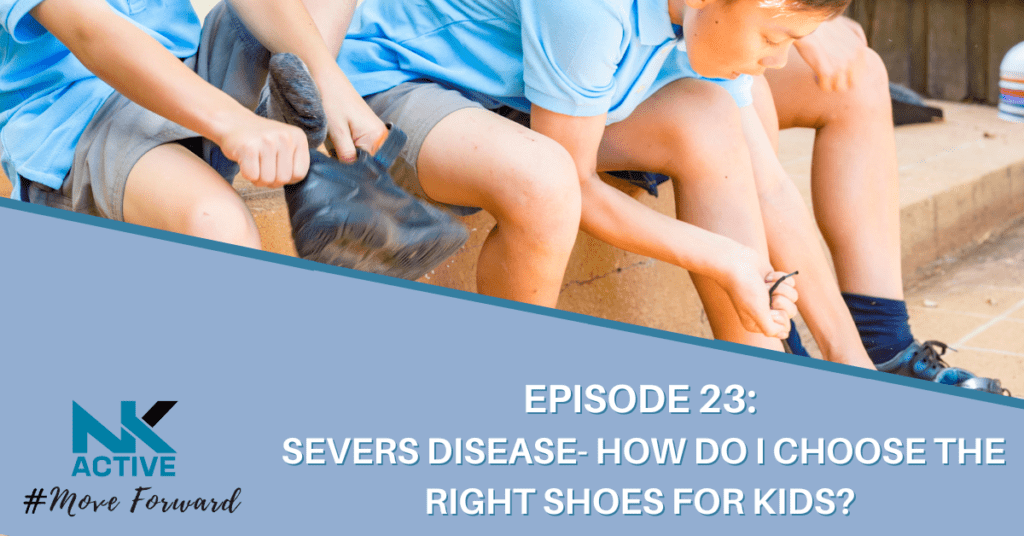
Severs Disease| How do I choose the right shoes for kids?
In the latest episode of the NK Active podcast we are talking about childrens footwear. One of the most common complaints we see in clinic for children presenting with heel pain is something known as Severs disease or calcaneus apophysitis. Shoe shops will tend to get really busy now as parents rush to get their children new shoes in readiness for the new school term.
And with this rush to buy our children new shoes we thought we would take the opportunity to discuss Childrens footwear and how to ensure we are choosing the right footwear for our kids.
It goes without saying that its important to make sure that they fit well. And actually with kids this tends to be one thing that we are good at. We regularly get our kids feet measured which is something we fail to do as adults. But there is this misconception out there that any children’s footwear has to be supportive if they’ve got a flatter looking foot. And that’s not actually the case. And actually, sometimes having a shoe that is too supportive, doesn’t really help the child with walking around, they can sometimes feel too heavy, it can make them feel a little more clumsy, so actually having a slightly more flexible shoe isn’t actually a bad idea. It doesn’t matter if the shoe is more flexible or if the shoe is slightly more supportive, it comes down to what is most comfortable for your child to wear.
Insoles and childrens footwear.
For some children, they may experience pain in their feet, and actually the use of foot orthosis can be really helpful to support them in their duration of activity that they’re doing. Sometimes the muscular skeletal structure is still maturing and part of that means that some of the softer surrounding tissues within the foot and lower leg are sometimes tighter, or more lapse. And so sometimes the children are having to use their muscle groups harder, and for longer periods of time, and therefore they can get symptoms. So orthosis in footwear can sometimes, for a short period of time, just be a tool that is used to help that child be more comfortable. For anyone who is then fitting orthosis in footwear, there is a need to be mindful that we are adding material into the shoe. And therefore the space in which the foot will sit will be smaller. This may mean that we need to then resize footwear in order to be able to make sure that both the foot and the foot orthosis can fit together.
What is severs disease?
Severs disease, or calcaneus apophysitis, is discomfort due to the growth plate maturing and this is found in the heel bone known as the calcaneus. Sometimes we can get a bit of inflammation that may be heat, swelling or warmth to that area. Children who typically present with this condition are usually around the ages of eight to thirteen, however, this can be earlier or slightly later. We tend to find that it is this kind of pain, an ache sensation that fits within the heel, that sometimes goes up into the arch of the foot or maybe around the ankle. Resting tends to make the symptoms more comfortable. However moving or doing sport like PE jumping or skipping tends to aggravate those symptoms.
As children start to increase their activity levels during their time at school we see a lot of children aggravating those growth plates a little bit more. Within clinic we will see an increased level of patients with severs disease as they return to activity after six weeks off for the holidays. By October they have had weeks of P.E. lessons, football clubs and after school activities. As an adult we might shrug this off as doing too much too soon, but for children in those four weeks returning back to school they may well have had a bit of a growth spurt and then need to understand how to manage that load appropriately.
Treatment of severs disease
When we start to talk about the treatment of severs part of this comes down to understanding load management and returning to activities gradually. But the other part relates to educating our patients that they can still return to activity and not do any long term damage whilst doing so. If the child gets to a point where its just too uncomfortable then yes, by all means stop, but normally from around the age of about sixteen years most symptoms of severs will start to resolve themselves. The reason for this is that by this point the growth plate fuses and calcaneus apophysitis dissipates.
If you have little people we do highly recommend that you listen to this short 12 minute episode in full as both Nick and Charlie talk in more detail about how you can relieve any discomfort that your child might have when wearing school shoes and how you can recognise if they might be dealing with severs.
Give it a listen and do let us know if you have any questions.
Listen on your chosen podcast platform here: https://kite.link/nk-active
Watch this episode on YouTube here: https://youtu.be/X1ACQloMwnM
If you would like to discuss anything you have heard in todays episode or have an injury that you would like to talk about we are absolutely here to help. Contact us at the clinic and we would be happy to book you in for a consultation.
